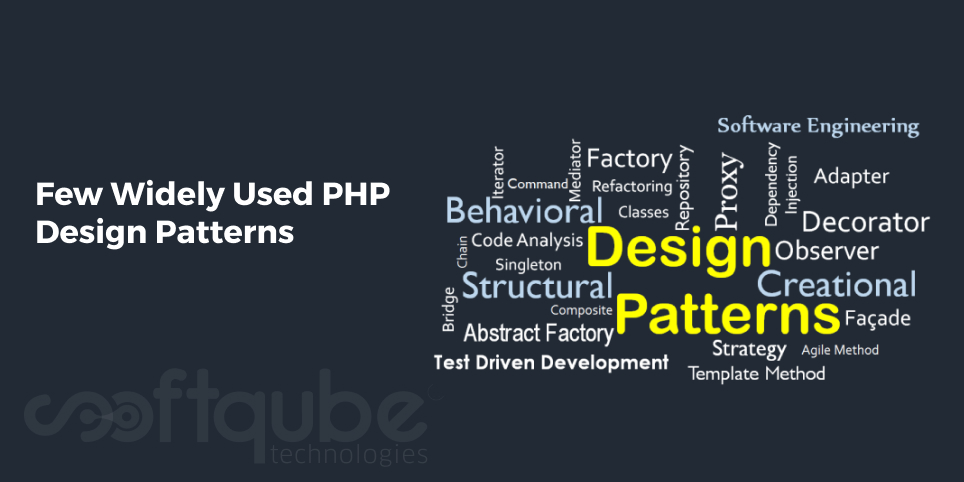Few Widely Used PHP Design Patterns
October 30, 2015

Most of the web development companies use PHP to develop web applications. However there are others that prefer other programming languages rather than PHP. This blog post is dedicated to those who use PHP as a programming language for creating web applications.
Also, the information shared here will be useful to all the PHP developers including beginners as well as experts. Like every other IT field, PHP is also a sector that keeps getting updated every now and then.
We feel that our readers must stay updated with the latest hip and happenings of the IT industry and so every time we bring to you the information about new updates available in the market. Today, we will discuss about some PHP Design Patterns that are used to solve certain common problems which occur while developing an application.
These design patterns serve as a quick solution to the frequently occurring problems which may be small but sometimes these small problems can be a big hassle to finish the work. As a result, it is necessary to find the immediate solution to such issues.
So, here are the PHP Design Patterns that serve as immediate solutions:
- Single Design: This is known as Singleton Design Pattern which is based on the idea of singleton set ({}) in mathematics. It is an implementation of the Responsibility Pattern. This can be easily understood by those who are aware about PHP patterns.This Singleton design pattern can be used to solve important programming tasks however it depends on the needs. So a Singleton Pattern is useful when you have a shared source such as a printer, file manager, database connection, loggers and so on.
-
Describe any private static member variable for storing the class instance. This is known as object instance.
“private static $_instance = null; “
- Now, the class constructor is to be locked down considering it as private and this will make the class uninstantiable.
“private function __construct() { }”
- The external instantiation of copies of singleton class is to be stopped as to avoid duplicate objects.
public function __clone() {
trigger_error( "Cannot clone instance of Singleton pattern ...", E_USER_ERROR );
}
public function __wakeup() {
trigger_error('Cannot deserialize instance of Singleton pattern ...', E_USER_ERROR ); - Use a public static method to create single instance of that class. This will check whether the single instance for that class is already available or not and if it is available then the same instance will be repeated every time it is called for.
Or another similar instance will be created containing static member variable and returns it.
public static function getInstance()
{
if( !is_object(self::$_instance) )
//or if( is_null(self::$_instance) ) or if( self::$_instance == null )
self::$_instance = new self;
//or, in PHP 5.3.0
//if (empty(static::$_instance)) {
// $class = get_called_class();
// static::$_instance = new $class;
//}
return self::$_instance;
}This completes the process of creating a singleton class template. Create a test to check the multiple instances of singleton class.
- Factory: Another widely used PHP Design Pattern is Factory design pattern. It is mainly used in software development to cover all the processes that are used for creating objects and which allow object instantiation during run time.
It is mainly responsible for object manufacturing. So, basically this design pattern is used when object creation prevents the reuse without duplicating the code. Object creation process needs information that is irrelevant to be included in the composing object.
Factory pattern is used to create objects using factory method pattern as well as abstract factory pattern.
- Decorator: This is also known as Wrapper. This pattern is used to elaborate the object behaviour without being affected by sub classing or behaviour of the objects from the similar class.
This means this structural design pattern is used when we want one PHP object to perform several tasks at the same time. Such objects are known as target objects. This pattern is used in almost all languages in all platforms including UI to backend.
Generally, this pattern is used to add flexibility and runtime specific behaviour.
- Façade: The Façade design pattern is one of the PHP patterns that is used to make complex systems easy to understand as these systems have huge number of interdependent classes and it offers a simple interface to the client.
.jpg)
This façade pattern relates to an object that offers a simple interface to a huge code like as class library.
Hence, we can say that a façade object can be used to perform following tasks:
- Making complex systems easy to use
- Making library readable
- Reduce dependency on outside code
- Beautifully cover a certain collection of APIs with single well designed API.
So, next time you want a complex system to be transformed into an easy one then you can take advantage of Façade pattern.
Once you have developed a PHP singleton class template then the singleton PHP class can be developed with these rules:
Wind Up:
So, that’s it for the day. More of such PHP design patterns are available. However, we have collected the information for those that are widely useful. Stay connected with us for more such PHP updates.
And in case you need any type of PHP assistance then get in touch with our experts at Softqube Technologies, PHP Development India.
Share on







